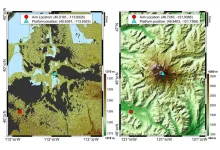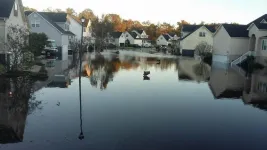(Press-News.org) DURHAM, N.C. – The world around us is constantly being flash photographed by adaptive radar systems. From salt flats to mountains and everything in between, adaptive radar is used to detect, locate and track moving objects. Just because human eyes can’t see these ultra-high frequency (UHF) ranges doesn’t mean they’re not taking pictures.
Although adaptive radar systems have been around since World War II, they’ve hit a fundamental performance wall in the past couple of decades. But with the help of modern AI approaches and lessons learned from computer vision, researchers at Duke University have broken through that wall, and they want to bring everyone else in the field along with them.
In a new paper published July 16 in the journal IET Radar, Sonar & Navigation, Duke engineers show that using convolutional neural networks (CNNs) — a type of AI that revolutionized computer vision — can greatly enhance modern adaptive radar systems. And in a move that parallels the impetus of the computer vision boom, they have released a large dataset of digital landscapes for other AI researchers to build on their work.
“Classical radar methods are very good, but they aren’t good enough to meet industry demands for products such as autonomous vehicles,” said Shyam Venkatasubramanian, a graduate research assistant working in the lab of Vahid Tarokh, the Rhodes Family Professor of Electrical and Computer Engineering at Duke. “We’re working to bring AI into the adaptive radar space to tackle problems like object detection, localization and tracking that industry needs solved.”
At its most basic level, radar is not difficult to understand. A pulse of high-frequency radio waves is broadcast, and an antenna gathers data from any waves that bounce back. As technology has advanced, however, so too have the concepts used by modern radar systems. With the ability to shape and direct signals, process multiple contacts at once, and filter out background noise, the technology has come a long way in the past century.
But radar has come just about as far as it can using these techniques alone. Adaptive radar systems still struggle to accurately localize and track moving objects, especially in complex environments like mountainous terrain.
To move adaptive radar into the age of AI, Venkatasubramanian and Tarokh were inspired by the history of computer vision. In 2010, researchers at Stanford University released an enormous image database consisting of over 14 million annotated images called ImageNet. Researchers around the world used ImageNet to test and compare new AI approaches that became industry standard.
In the new paper, Venkatasubramanian and his collaborators show that using the same AI approaches greatly improves the performance of current adaptive radar systems.
“Our research parallels the research of the earliest users of AI in computer vision and the creators of ImageNet, but within adaptive radar,” Venkatasubramanian said. “Our proposed AI takes as input processed radar data and outputs a prediction of the target's location through a simple architecture that can be thought of as paralleling the predecessor of most modern computer vision architectures.”
While the group has yet to test their methods in the field, they benchmarked their AI’s performance on a modeling and simulation tool called RFView®, which gains its accuracy by incorporating the Earth's topography and terrain into its modeling toolbox. Then, continuing in the footsteps of computer vision, they created 100 airborne radar scenarios based on landscapes from across the contiguous United States and released it as an open-source asset called “RASPNet.”
This is a valuable asset, as only a handful of teams have access to RFView®. The researchers, however, received special permission from the creators of RFView® to build the dataset — which contains more than 16 terabytes of data built over the course of several months — and make it publicly available.
“I am delighted that this groundbreaking work has been published, and particularly that the associated data is being made available in the RASPNet repository,” said Hugh Griffiths, Fellow Royal Academy of Engineering, Fellow IEEE, Fellow IET, OBE, and the THALES/Royal Academy Chair of RF Sensors at University College London, who was not involved with the work. “This will undoubtedly stimulate further work in this important area, and ensure that the results can readily be compared with each other.”
The scenarios included were handpicked by radar and machine learning experts and have a wide range of geographical complexity. On the easiest side for adaptive radar systems to handle is the Bonneville Salt Flats, while the hardest is Mount Rainier. Venkatasubramanian and his group hope that others will take their ideas and dataset and build even better AI approaches.
For example, in a previous paper, Venkatasubramanian showed that an AI tailored to a specific geographical location could achieve up to a seven-fold improvement in localizing objects over classical methods. If an AI could select a scenario on which it had already been trained that is similar to its current environment, it should substantially improve in performance.
“We think this will have a really big impact on the adaptive radar community,” Venkatasubramanian said. “As we move forward and continue adding capabilities to the dataset, we want to provide the community with everything it needs to push the field forward into using AI.”
This work was supported by the Air Force Office of Scientific Research (FA9550-21-1-0235, 20RYCORO51, 20RYCOR052).
CITATIONS: “Data-Driven Target Localization Using Adaptive Radar Processing and Convolutional Neural Networks,” Shyam Venkatasubramanian, Sandeep Gogineni, Bosung Kang, Ali Pezeshki, Muralidhar Rangaswamy, Vahid Tarokh. IET Radar, Sonar & Navigation, July 16, 2024. DOI: 10.1049/rsn2.12600
“RASPNet: A Benchmark Dataset for Radar Adaptive Signal Processing Applications,” Shyam Venkatasubramanian, Bosung Kang, Ali Pezeshki, Muralidhar Rangaswamy, Vahid Tarokh. arXiv preprint arXiv:2406.09638
# # #
END
Revolutionizing the abilities of adaptive radar with AI
AI approaches and an enormous open-source dataset could spark rapid advancements in adaptive radar systems similar to those seen in computer vision over the past two decades.
2024-07-19
ELSE PRESS RELEASES FROM THIS DATE:
Plastic waste can now be converted to electronic devices
2024-07-19
University of Delaware and Argonne National Laboratory have come up with a chemical reaction that can convert Styrofoam into a high-value conducting polymer known as PEDOT:PSS. In a new paper published in JACS Au, the study demonstrates how upgraded plastic waste can be successfully incorporated into functional electronic devices, including silicon-based hybrid solar cells and organic electrochemical transistors.
The research group of corresponding author Laure Kayser, assistant professor in the Department of Materials Science and Engineering in ...
Health equity scholar Darrell Hudson named Health Behavior and Health Education chair at the University of Michigan School of Public Health
2024-07-19
Leading health equity researcher Darrell Hudson, MPH ‘05, PhD ‘09, has been named chair of the Department of Health Behavior and Health Education at the University of Michigan School of Public Health. His appointment for a five-year term, effective August 26, 2024, was approved by the University of Michigan Board of Regents this week.
“Dr. Hudson has solidified his national reputation as a leading health equity scholar, making impactful research contributions through rigorous, interdisciplinary, and innovative scholarship,” said F. DuBois Bowman, dean of Michigan Public Health. “His research is timely ...
Research will establish best ‘managed retreat’ practices for communities faced with climate change disaster
2024-07-19
LAWRENCE — Around the globe, communities at risk from repeated flooding due to climate change face stark decisions. Some communities in peril of flooding may resolve, or be urged, to relocate to a safer location — something known as “managed retreat.” In the United States, flood-prone communities in coastal states like Louisiana and Alaska already have commenced managed retreat inland.
“It's retreating from risk, and we hope to provide decision support for the equitable implementation ...
Marshall University awarded grant to further fentanyl addiction research
2024-07-19
HUNTINGTON, W.Va. – Marshall University was awarded a $3.3 million grant (#R01DA057931) from the National Institute on Drug Abuse (NIDA) to examine the genetic mechanisms that underlie fentanyl addiction.
In 2022, fentanyl overdose was the leading cause of death for U.S. adults aged 18 to 45, according to Families Against Fentanyl (2023).
“This alarming statistic highlights the urgent need to understand why some people are more susceptible to fentanyl addiction,” ...
Wash U researchers shine light on amyloid architecture
2024-07-19
By Leah Shaffer
Amyloid-beta (A-beta) aggregates are tangles of proteins most notably associated with neurodegenerative diseases like Alzheimer’s. Despite its constant stint in the limelight, however, researchers have been unable to get a good understanding of how A-beta comes together and breaks apart.
“The way A-beta behaves in a variety of environments, including the human brain, is elusive,” said Brian Sun, an electrical systems and engineering alumnus of Washington University in St. Louis who is now an MD/PhD student in the School of Medicine.
“There’s an understanding of growth and decay that isn’t ...
New dawn for space storm alerts could help shield Earth's tech
2024-07-19
New dawn for space storm alerts could help shield Earth's tech
Royal Astronomical Society press release
RAS PR 24/22 (NAM 8)
For immediate release
Space storms could soon be forecasted with greater accuracy than ever before thanks to a big leap forward in our understanding of exactly when a violent solar eruption may hit Earth.
Scientists say it is now possible to predict the precise speed a coronal mass ejection (CME) is travelling at and when it will smash into our planet – even before it has fully erupted from ...
Tomorrow’s super battery for electric cars is made of rock
2024-07-19
In 10 years, solid-state batteries made from rock silicates will be an environmentally friendly, more efficient and safer alternative to the lithium-ion batteries we use today. Researcher at DTU have patented a new superionic material based on potassium silicate - a mineral that can be extracted from ordinary rocks.
It is the battery in your electric car that determines how far you can drive on one charge and how quickly you can re-charge. However, the lithium-ion battery, the most widely used electric car battery today, has its limitations— in terms of capacity, safety and also availability. ...
Fecal immunochemical test screening and risk of colorectal cancer death
2024-07-19
About The Study: In this nested case-control study, completing fecal immunochemical test was associated with a lower risk of overall death from colorectal cancer, particularly in the left colon, and the associations were observed across racial and ethnic groups. These findings support the use of fecal immunochemical test in population-based screening strategies.
Corresponding Author: To contact the corresponding author, Chyke A. Doubeni, M.D., M.P.H., email chyke.doubeni@osumc.edu.
To access the embargoed ...
Long-term use of oral corticosteroids and safety outcomes for patients with atopic dermatitis
2024-07-19
About The Study: Oral corticosteroid use of more than 90 days per year among individuals with atopic dermatitis was associated with a small increased risk of composite adverse outcomes in this large population-based case-control study. Future investigations are warranted to confirm this potential risk of adverse events (AEs) associated with long-term use of oral corticosteroids for patients with exacerbations of atopic dermatitis, and health care professionals should thoroughly weigh the benefits associated with oral corticosteroids ...
Diagnosing solid lesions in the pancreas with multimodal AI
2024-07-19
About The Study: In this randomized crossover trial of diagnosing solid lesions in the pancreas with or without artificial intelligence (AI) assistance, the joint-AI model demonstrated positive human-AI interaction, which suggested its potential to facilitate a clinical diagnosis. Nevertheless, future randomized clinical trials are warranted.
Corresponding Authors: To contact the corresponding authors, email Aiming Yang, M.D. (yangaiming@medmail.com.cn) and Bin Cheng, M.D. (b.cheng@tjh.tjmu.edu.cn).
To access the embargoed study: Visit our For The Media website at this link https://media.jamanetwork.com/
(doi:10.1001/jamanetworkopen.2024.22454)
Editor’s ...
LAST 30 PRESS RELEASES:
Autonomous AI agents developed to detect early signs of cognitive decline
Study finds ocean impacts nearly double economic cost of climate change
Increased deciduous tree dominance reduces wildfire carbon losses in boreal forests
Researchers discover how a respiratory bacterium obtains essential lipids from the human body and targets fat-rich tissues
Locust swarms destroy crops. Scientists found a way to stop that
More resources and collaboration needed to support prevention and treatment of obesity
Two types of underconfidence linked to anxiety and gender
Insects are victims too: Global study shows impacts of invasive alien species on populations
Pioneering natural, degradable polymer capsules
Forestry is becoming digital and automated
Maternity baby deaths much higher in northern England than in the South
Mosquitoes’ thirst for human blood has increased as biodiversity loss worsens
The stop-smoking medication varenicline may also work for cannabis use disorder
Potential new treatment for sepsis
Study reveals how many hours of video games per week might be too many
Electrospinning for mimicking bioelectric microenvironment in tissue regeneration
Home fingertip oxygen monitors less accurate for people with darker skin tones
Six weeks in a cast no less effective than surgery for unstable ankle fractures
Precautionary approach to alcohol-free and low alcohol drinks needed to protect public health, say experts
Gas-atomized Ca–Mg alloy powders produce hydrogen simply by adding water — high-efficiency hydrogen generation at room temperature
British redcoat’s lost memoir reveals harsh realities of life as a disabled veteran
World-leading rare earth magnet recycling facility launches in UK
Corday Selden selected for the Oceanography Society Early Career Award
MIT chemists determine the structure of the fuzzy coat that surrounds Tau proteins
Same moves, different terrain: How bacteria navigate complex environments without changing their playbook
Severe weather is deadly for vulnerable older adults long after the storm ends, study finds
Expert panel highlights opportunities for improving cancer studies
Hearing aid prescriptions not associated with changes in memory and thinking
Seth Zippel selected for The Oceanography Society Early Career Award
Jeremy Horowitz selected for The Oceanography Society Early Career Award
[Press-News.org] Revolutionizing the abilities of adaptive radar with AIAI approaches and an enormous open-source dataset could spark rapid advancements in adaptive radar systems similar to those seen in computer vision over the past two decades.






